What is equity and why is it important? This article in Community College Daily describes equity as “unfinished business” for community colleges across the country. While community colleges have long been focused on (and excelled at) open access and second chances, we haven’t done nearly as good a job with our focus on equitable student outcomes – that is, success for all students.
ACC recently updated its strategic plan to put equity front and center in all our work. When you visit that link, you’ll see that our priorities are:
- Equity and Access: Increase annual unduplicated enrollment at ACC to 85,000 students by 2030 through equity focused connection and entry processes.
- Persistence and Engagement: Develop an equitable and inclusive learning and student support environment that increases fall-to-fall persistence rates to 58 percent for all students.
- Completion and and Transition to Employment/Transfer: Achieve equitable results in completion and increase annual credential awards to 15,000 by 2030 to improve transfer and employment outcomes for all ACC students.
- Effective and Efficient Operations and Infrastructure: Ensure an organizational environment that promotes equitable student and employee success through effective and efficient operations and infrastructure.
Why does the year 2030 serve as a benchmark? Because the higher education strategic plan for the State of Texas is 60x30TX, and one of its main goals is for 60 percent of Texans ages 25-34 to have a postsecondary credential by 2030.
Here at ACC we’ve spent the last year working intentionally to embed an equity framework into our faculty hiring processes. What does that mean? Equity does not mean equality, nor does equity mean diversity. Strategic diversity may be a tactic along the way to equity, but our equity work in faculty hiring is aimed at helping us do a better job of finding faculty who celebrate who our students are and what they bring to the table, who regularly examine inequality in student outcomes, who assess their teaching practices that might contribute to those unequal outcomes, and who seek to help all students succeed.
Equity can mean differential supports in the classroom because not all students are equal in talents or abilities or skills, just as not all faculty or staff (or administrators) are equal in talents or abilities or skills.
Equity can mean moving away from traditional, standardized “tests” to more nuanced means of assessing student learning – including project-based assessments, research assignments, or in-class active and applied learning opportunities.
Equity requires a certain cultural humility so that our examples and illustrations in the classroom, our required readings, our references, even our jokes all reflect and respect the variety of backgrounds and perspectives in the classroom.
Equity requires us to look at our institutional policies and practices with a fresh perspective, seeking out ways in which those policies and practices might perpetuate unintended but undeniable inequitable treatment and outcomes. But it’s not enough to look for those embedded institutional biases, we must also then act to change those policies and practices.
Equity requires much of all of us – professional development, self-awareness, willingness to change, intentional practice in language, interactions, and course design, mutual respect, and so much more.
One of the leaders in this work in higher education is the Center for Urban Education under the direction of Dr. Estela Mara Bensimon. There are a multitude of resources on CUE’s website, but here‘s just one. I had the good fortune a year ago to attend CUE’s Equity in Faculty Hiring Institute for community colleges. I was reminded that we all have implicit biases that show up in our decision-making around whom to hire. Without self-reflection and self-awareness, it’s too easy to rely on unconscious stereotypes. And given our hiring processes – limited information about candidates, multiple commitments in addition to serving on hiring committees, being asked to evaluate multiple applicants in a short period of time, our inclination to prefer candidates who look or act or think or were educated like us, little time to discuss as a committee notions of “merit” and “fit”, and so on – it requires great focus and intentionality to revitalize our hiring practices to ensure that equity-mindedness is at the center. It requires everyone to commit to that focus and intentionality. It requires us all to recognize that we can, should, and must do better.
Our focus on equity in faculty hiring asks us all to recognize that we are subject to the influence of implicit biases and assumptions, both personal and institutional. The Equity in Faculty Hiring Steering Committee made a variety of decisions aimed at embedding equity-mindedness in faculty hiring. We required hiring committees to diversify (for instance, to ask for a faculty member outside of the program to serve on the committee). We posted and advertised our full-time faculty jobs for 90 days to build a rich, deep, and broad applicant pool. We completely rewrote the job posting to describe who we are, whom we serve, and whom we want to join us. We asked each applicant to submit not only a letter of interest and a CV, but also a statement of teaching philosophy and an equity statement. We eliminated the “preferred” qualifications in academic transfer postings that often became de facto required qualifications and served as a means of inequitably reducing the applicant pool. We offered hiring committees sample equity-minded interview questions and an equity-minded summative evaluation rubric. We encouraged hiring committees to conduct two rounds of interviews, the first via Skype or Zoom with a wide range of candidates, and the second in person with the finalists. In other words, we encouraged hiring committees to use inclusion strategies rather than exclusion strategies when deciding whom to consider.
Was it perfect? Of course not. Can we do better next year? Absolutely. Equity is a journey, but you should know that it is at the heart of ACC’s work going forward. I invite you to join me on the journey.

 Buckle up, and hold onto your hats!
Buckle up, and hold onto your hats!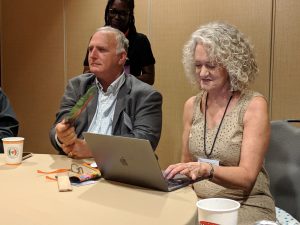
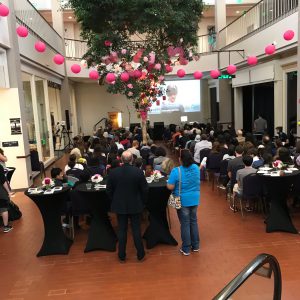 Each winning poet is recorded by KLRU reading their poem, and the videos are played at the event.
Each winning poet is recorded by KLRU reading their poem, and the videos are played at the event. 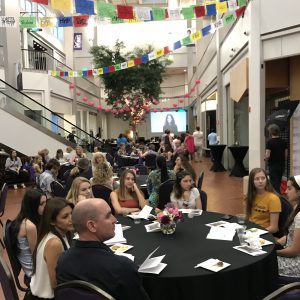

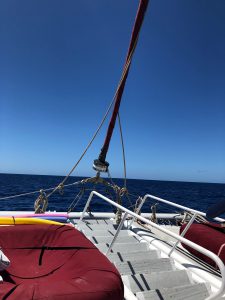



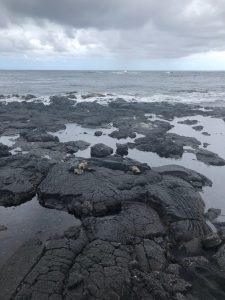
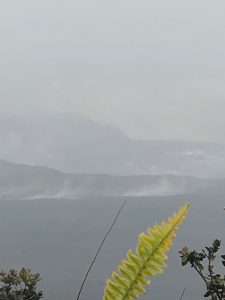
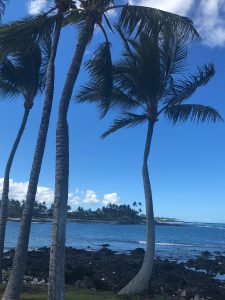

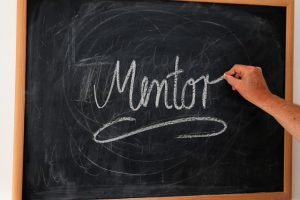 We are launching a faculty mentoring program here. I wrote about it in an earlier post, so this is the second verse of the faculty mentoring song. The
We are launching a faculty mentoring program here. I wrote about it in an earlier post, so this is the second verse of the faculty mentoring song. The 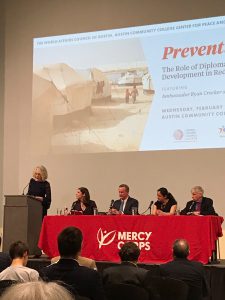 Yes, sometimes this job comes with remarkable opportunities – and I got to meet and chat with two towering public servants. I also had the privilege of sharing the stage with them (briefly) while welcoming everyone to this event. Thanks to the hard work of Dr. Shirin Khosropour, Department Chair for Interdisciplinary Studies and Director of the Peace and Conflict Studies Center, ACC hosted a full house in the multipurpose room at EVC to hear from sage and seasoned foreign policy experts. It was a great event, and illustrates the scope of the work that we do here at ACC to the benefit of our students and our community.
Yes, sometimes this job comes with remarkable opportunities – and I got to meet and chat with two towering public servants. I also had the privilege of sharing the stage with them (briefly) while welcoming everyone to this event. Thanks to the hard work of Dr. Shirin Khosropour, Department Chair for Interdisciplinary Studies and Director of the Peace and Conflict Studies Center, ACC hosted a full house in the multipurpose room at EVC to hear from sage and seasoned foreign policy experts. It was a great event, and illustrates the scope of the work that we do here at ACC to the benefit of our students and our community.